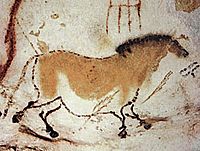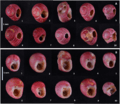Cro-Magnon facts for kids
The Cro-Magnon were early modern humans (early Homo sapiens). They lived in Europe during the Upper Palaeolithic period. Some anthropologists use the term "European early modern humans" to describe the Cro-Magnons.
The earliest known Cro-Magnon remains are between 35,000 and 45,000 years old, based on radiometric dating. The oldest remains, from 43,000 – 45,000 years ago, were found in Italy and Britain. Other remains also show that Cro-Magnons reached the Russian Arctic about 40,000 years ago.
Cro-Magnons had powerful bodies, which were usually heavy and solid with strong muscles. Unlike Neanderthals, which had slanted foreheads, the Cro-Magnons had straight foreheads, like modern humans. Their faces were short and wide with a large chin. Their brains were slightly larger than the average human's is today.
Naming
The name "Cro-Magnon" was created by Louis Lartet, who discovered the first Cro-Magnon skull in southwestern France in 1868. He called the place where he found the skull Abri de Cro-Magnon. Abri means "rock shelter" in French; cro means "hole" in the Occitan language; and "Magnon" was the name of the person who owned the land where Lartet found the skull. Basically, Cro-Magnon means "rock shelter in a hole on Magnon's land."
This is why scientists now use the term "European early modern humans" instead of "Cro-Magnons." In the scientific system which puts living things into categories, the term "Cro-Magnon" means nothing.
Cro-Magnon life
Anatomy
Mostly, the Cro-Magnon's bodies were shaped like humans' bodies are today. They had the same organs and other body parts that allow today's humans to speak, so the Cro-Magnons could also speak.
Culture
Unlike the Neanderthals, who focused more on just surviving, the Cro-Magnons created art, carefully made tools, made jewelry, and had their own culture. For example, the Cro-Magnons:

- Carefully worked bone, antler points, and flint points to make their weapons work much better
- Made statues of Venus
- Did cave paintings
- Used bones, shells, and teeth to make jewelry
- Spun, dyed, and tied knots in flax, to make cords for their tools, make baskets, or sew clothing
Like most early humans, the Cro-Magnons mostly hunted large animals. For example, they killed mammoths, cave bears, horses, and reindeer for food. They hunted with spears, javelins, and spear-throwers. They also ate things that came from plants.
The Cro-Magnons were nomadic or semi-nomadic. This means that instead of living in just one place, they followed the migration of the animals they wanted to hunt. They may have built hunting camps from mammoth bones; some of these camps were found in a village in the Ukraine. They also made shelters from rocks, clay, tree branches, and animal fur.
Related pages
Images for kids
-
Potential EEMH musical instruments: bone flute (left), whistle (centre), idiophone (bottom), and bullroarer (top)
-
EEMH tribe in H. G. Wells' The Grisly Folk











